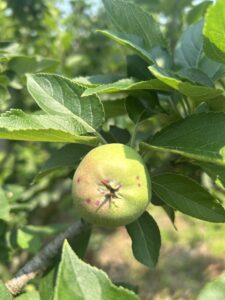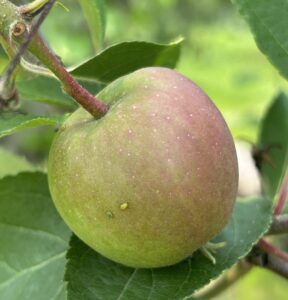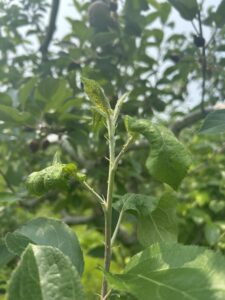Peach:
Bacterial Spot: Fruit symptoms from this set of infections have begun to appear in southern counties. So far fruit symptoms are very low and only in highly susceptible varieties. Peaches are at or past pit hardening and fruit now has some resistance to bacterial spot. Infections can still occur but will be less unsightly and may still make grade. Growers should continue to manage using Oxytetracycline and lower rates of copper, especially around rainy periods and severe weather.
Rusty Spot: Rusty spot infections are appearing on fruit across New Jersey and ongoing until pit hardening. Maintain coverage through second cover with effective materials such as Rally, Rhyme, or potassium bicarbonate products. Other choices include Flint Extra, Inspire Super, and Luna Sensation.
Peach Scab: Maintain good coverage with captan or other effective fungicides until July in orchards where scab was an issue last year.
Oriental Fruit Moth: A biofix point for OFM was set on 4/2 for southern counties and 4/17 in northern counties. Treatment timings targeting the second generation are shown in the table below.
| OFM 2nd Generation Timing | ||||
| Insecticide Type | ||||
| County/Region | Degree Days by 6/16 base 45 | Conventional
1150-1200 1450-1500 |
Intrepid/Rimon
1050-1150 1300-1400 |
Diamides/Virus
1075-1150 1375-1450 |
| Gloucester – Southern | 1265 | 1st –past
2nd – June 23-26 |
1st –past
2nd – June 17-20 |
1st –past
2nd – June 20-23 |
| Middlesex – Northern | 1110 | 1st – June 18-20
2nd – too far off |
1st – June 13-18
2nd – too far off |
1st – June 14-18
2nd – too far off |
Tarnished Plant Bugs and Other Catfacing Insects: Tarnished plant bug and other catfacing insects are active, and activity is increasing with dry weather and summer temperatures. There has been very little recent fruit feeding observed.
Green Peach Aphid: Green peach aphid counts have decreased significantly at most farm sites, but a few scouted blocks had pressure above threshold. If more than 1 colony of aphids are found in nectarines, or 2-3 colonies are found in peaches, an insecticide for aphids is needed. See the NJ Commercial Tree Fruit Production Guide for recommended materials and rates.
Scale Insects: White peach scale and San Jose scale crawlers began emergence around May 26 and will continue emergence for up to 6 weeks (Figure 1). Control options during crawler emergence include Neonicitiniods (suppression only), Sivanto, and the IGR’s Esteem and Centaur. See the NJ Commercial Tree Fruit Production Guide and the product labels for more information.

Figure 1. Scale feeding on apple.
Thrips: Increased thrips activity was recorded last week. Thrips damage appears as “silvering” and usually appears on fruit close to harvest. If populations are high, damage can be extensive. Delegate or Entrust at the highest labeled rate are the usual recommended materials for thrips in stone fruit. These materials all have short PHI’s and may be applied close to harvest when damage typically appears. Thrips have also been observed to mark cherries. Damage is different than peach and appears as a dark streak in a similar pattern as silvering. See the NJ Commercial Tree Fruit Production Guide for more information.
Apples and Pears:
Diseases: Now that primary scab has ended, the focus turns toward summer diseases such as fruit rots (Bitter rot), and sooty blotch and fly speck. Bitter rot control has been difficult at best in recent years even where management programs have been rigorous. Research has suggested products such as Merivon, Luna Sensation, Inspire Super, Omega, and Aprovia may be effective, and longtime reliable broad spectrum fungicides such as captan and ziram should provide control. Experience has suggested that the addition of phosphorous acid products such as Prophyt or Rampart to captan sprays may improve control. Observations are that these products improve control of other summer diseases such as sooty blotch and flyspeck, and may help suppress scab infections where present. Scab symptoms are appearing in some orchards statewide.
Fire Blight: Fire Blight symptoms began appearing in southern county apple orchards the week of 5/19. Typically it is recommended to cut out infected limbs; however, this is a practical decision that must be made. This blog post from Michigan State may be helpful to decide whether it is worth cutting out infected tissue. Once the terminal buds set, typically in July, infected wood should be removed to prevent colonization by the bitter rot pathogen.
Codling Moth (CM): A codling moth biofix was set in southern counties on 4/28 and in northern counties on 4/30. Trap captures increased in some orchards this week. Second generation timings are updated below. Rimon is not recommended for this and later generations.
| Codling Moth Degree Day Timing – Second Generation | ||||||||
| Application and Insecticide Type | ||||||||
| County Area | Biofix | Rimon:
75-100DD + 14-17 days later
|
Intrepid
1150 + 1450 DD Diamides – Altacor, Voliam mixes: (150-200 DD) |
Madex
1250 DD + every 7-9 days during brood hatch (later if first spray is an IGR) |
Standard Insecticides – Delegate, Avaunt, OP’s, carbamates, pyrethroids
1250 DD + 1550 DD
|
|||
| DD | 1150 | 1450 | 1250 | 1250 | 1550 | |||
| Southern | April 28 | past | past | too far off | too far off | too far off | too far off | too far off |
| Northern | April 30 | past | past | too far off | too far off | too far off | too far off | too far off |

Figure 2. Aphids on fruit.
Wooly Apple Aphid (WAA); Green Apple (Spirea) Aphids (GAA): GAA colonies are being observed, some above threshold in some apple blocks (Figures 2 & 3). GAA is generally a pest that can be tolerated in orchards where beneficial insects are present. Generally treatment thresholds for GAA are if 50% of the shoots are infested where no beneficial insects are present. WAA aerial colonies are also forming in orchards statewide. See the NJ Commercial Tree Fruit Production Guide for more information on effective products at this time.

Figure 3. Green apple aphid colonies on younger branches.
Pear: Pear psylla are still actively laying eggs and nymphs continue to hatch. Options for control include spinosyn products such as Delegate and Entrust, and the neonicotinoids (IRAC group 4A). The addition of 0.25-1 gal of summer oil may improve control. Other options at this time include products containing abamectin. Be sure to read and follow the label instructions regarding the addition of penetrants for abamectin products.
Grape: The biofix in southern counties for Grape berry moth (GBM) was 5/24. Model timing will predict IGR and diamide materials for the second generation. The model works best when growers record their own bloom dates and use the Grape Berry Moth model at NEWA. The timing is set at 810 degree days base 470F for the second generation treatments using Diamides or Intrepid. Other materials may be applied a few days later. Given the current weather patterns, this should be about the last week of June in southern counties. As for diseases we are seeing low levels of phomopsis on older leaves in some vineyards.
Blueberry: Spotted-wing drosophila (SWD) and Oriental beetle (OB) captures increased from the previous week. The first catch of Blueberry Maggot (BBM) was recorded on June 12. For weekly reports on blueberry pests and recommendations read the Rutgers Blueberry Bulletin.
Phenology Table: Based on annual observations made in Gloucester County.
| Pest Event or Growth Stage | Approximate Date | 2025 Observed Date |
| Bud Swell (Redhaven/PF-17) | March 23 +/- 15 Days | March 30 |
| 1/4″ Green Tip Red Delicious | March 31 +/- 13 Days | March 30 |
| Pink Peach (Redhaven/PF-17) | April 4 +/- 15 Days | April 1 |
| Tight Cluster Red Delicious | April 9 +/- 13 Days | April 5 |
| Full Bloom Peach (Redhaven/PF-17) | April 9 +/- 14 Days | April 10 |
| Pink Apple (Red Delicious) | April 14 +/- 12 Days | April 16 |
| Full Bloom Apple (Red Delicious) | April 22 +/- 11 Days | April 25 |
| Petal Fall (Redhaven) | April 22 +/- 10 Days | April 19 |
| Petal Fall (Red Delicious) | April 27 +/- 13 Days | May 2 |
| Shuck Split (Redhaven) | April 30 +/- 11 Days | April 26 |
| Pit Hardening | June 15 +/- 9 Days | June 15 |
Tree Fruit Trap Captures – Southern Counties
| Week Ending | STLM | TABM-A | CM | BMSB | OFM-A | DWB | OFM-P | TABM-P | LPTB | PTB |
| 4/5/2025 | 0 | 0 | 0 | 0 | 0 | 0 | 0 | 0 | 0 | 0 |
| 4/12/2025 | 0 | 0 | 0 | 0 | 6 | 0 | 0 | 0 | 0 | 0 |
| 4/21/2025 | 0 | 0 | 0 | 0 | 36 | 0 | 1 | 0 | 0 | 0 |
| 4/27/2025 | 25 | 0 | 0 | 0 | 24 | 0 | 5 | 0 | 1 | 0 |
| 5/2/2025 | 517 | 0 | 4 | 0 | 12 | 0 | 6 | 0 | 13 | 0 |
| 5/9/2025 | 159 | 4 | 10 | 0 | 3 | 16 | 5 | 4 | 46 | 0 |
| 5/16/2025 | 91 | 11 | 6 | 0 | 1 | 36 | 2 | 14 | 69 | 0 |
| 5/23/2025 | 299 | 21 | 3 | 0 | 1 | 23 | 1 | 26 | 23 | 0 |
| 5/30/2025 | 399 | 14 | 2 | 0 | 0 | 41 | 1 | 11 | 10 | 3 |
| 6/6/2025 | 733 | 13 | 1 | 0 | 0 | 36 | 2 | 12 | 29 | 1 |
| 6/13/2025 | 684 | 19 | 2 | 1 | 0 | 81 | 2 | 17 | 22 | 8 |
Tree Fruit Trap Captures – Northern Counties
| Week Ending | STLM | TABM-A | CM | BMSB | OFM-A | DWB | OFM-P | TABM-P | LPTB | PTB | AMBROSIA BEETLE |
| 4/5/2025 | 387 | 0 | 0 | 0 | 0 | 0 | 0 | 0 | 0 | 0 | 0 |
| 4/21/2025 | 435 | 0 | 0 | 0 | 0 | 0 | 1.3 | 0 | 0 | 0 | 0 |
| 4/27/2025 | 26 | 0 | 0 | 0 | 0 | 0 | 25 | 0 | 0 | 0 | 72 |
| 5/2/2025 | 86 | 0 | 0.33 | 0 | 72.5 | 0 | 47.2 | 0 | 0 | 0 | 136 |
| 5/9/2025 | 56 | 0 | 5.3 | 0 | 58.8 | 0 | 22.9 | 0 | 0 | 0 | 145 |
| 5/16/2025 | 13.75 | 2.6 | 7.3 | 0 | 4 | 0 | 5 | 0 | 0 | 0 | 50.5 |
| 5/23/2025 | 4.8 | 10.3 | 10.5 | 0 | 0.6 | 31.25 | 4.2 | 0 | 14.6 | 1 | 22.2 |
| 5/30/2025 | 2.2 | 4.8 | 1.8 | 0 | 0 | 12.4 | 9.6 | 0 | 9.6 | 1.9 | 22.1 |
| 6/6/2025 | 3 | 4.83 | 2.8 | 0.25 | 0 | 20 | 4.1 | 0 | 21.2 | 1.8 | 40.3 |
| 6/13/2025 | 65 | 20 | 11.4 | 0.6 | 0 | 12.3 | 4 | 0 | 10.5 | 1.5 | 59.2 |

